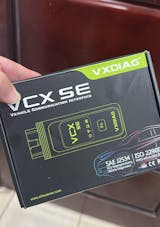仪表盘上的“检查引擎灯”不仅仅是一个烦人的玩意儿,它还是一个关键的警报系统,可以指示各种问题,从油箱盖松动到严重的引擎故障。了解如何重置“检查引擎灯”至关重要,但同样重要的是要认识到,仅仅关闭指示灯而不解决根本问题可能会导致更严重的问题。本指南将逐步指导您如何重置“检查引擎灯”,并提供解决根本原因的建议。
1. 了解检查引擎灯
发动机故障灯是车载诊断系统 (OBD) 的一部分。当 OBD 系统检测到问题时,它会触发发动机故障灯来提醒您。常见问题包括发动机、变速箱、排放控制系统或其他关键部件的问题。
为什么检查引擎灯很重要
OBD 系统持续监控车辆性能。如果传感器检测到异常情况,它会向车辆电脑发送信号,电脑会点亮“发动机故障灯”。虽然有些问题可能很小,但有些问题可能预示着严重的问题,如果置之不理,可能会导致昂贵的维修费用,甚至危及驾驶安全。
发动机故障灯亮起的常见原因
- 油箱盖松动或损坏:这是灯亮的最常见原因之一。
- 氧气传感器故障:氧气传感器监测排气系统中未燃烧的氧气量。
- 催化转化器故障:这会将有害气体转化为危害较小的排放物。
- 火花塞或电线损坏:火花塞点燃发动机燃烧室中的燃料/空气混合物。
2. 重置灯光之前先解决问题
在尝试重置“检查引擎灯”之前,务必诊断并修复潜在问题。忽略警告可能会导致更严重的后果,包括:
- 长期损害:如果发动机或其他系统运行不正常,可能会造成长期损害。例如,忽视更换火花塞可能会导致催化转化器损坏,维修费用高昂。
- 安全检查失败:点亮的发动机检查灯可能会导致您的车辆无法通过安全检查,从而导致在某些地区驾驶车辆属于违法行为。
- 排放量增加:发动机故障会导致更高的排放量,这不仅在许多地方是违法的,而且还会危害环境。
- 燃油经济性差:如果发动机运转效率不高,就会消耗更多燃料,从长远来看会花费您更多的钱。
3. 如何重置检查引擎灯
问题解决后,您可以使用多种方法重置“检查引擎灯”。以下是每种方法的详细说明:
A.使用OBD2扫描仪
OBD2 扫描仪是重置检查引擎灯最可靠、最直接的方法。
步骤:
- 连接扫描仪:将 OBD2 扫描仪插入 OBD2 端口,通常位于方向盘附近。
- 打开点火装置:将点火开关切换至 ON 位置,但不要启动发动机。
- 阅读代码:使用扫描仪读取系统中存储的诊断故障代码 (DTC)。
- 擦除代码:解决问题后,使用扫描仪清除代码,这应该会关闭检查引擎灯。
- 查看:关闭点火装置,然后启动汽车,以确保灯已重置。
笔记:如果清除代码后检查引擎灯再次亮起,则问题可能尚未完全解决。
B. 电池断开技术
如果您没有 OBD2 扫描仪,断开汽车电池是重置“检查引擎灯”的另一种方法。此方法很简单,但可能会重置车辆的其他系统,例如音响或座椅记忆功能。
步骤:
- 断开负极端子:使用扳手拆下电池负极端子。
- 耗尽电力:按下汽车喇叭或打开前灯以耗尽系统中剩余的电量。
- 等待:让车辆静置约 15 分钟。
- 重新连接电池:重新牢固地连接负极端子。
- 启动汽车:打开点火开关,查看检查引擎灯是否已熄灭。
笔记:如果灯仍然亮着,可能需要进一步诊断和修复。
C. 循环打开和关闭点火装置
另一种无需工具即可重置“检查引擎灯”的方法是循环打开和关闭点火开关。此方法适用于某些车辆,只需重置电脑即可。
步骤:
- 打开点火装置:将点火开关切换至 ON 位置,但不要启动发动机。
- 关掉点火装置:几秒钟后关闭点火装置。
- 重复:重复此过程三到五次。
- 检查灯光:启动车辆,查看灯是否已重置。
笔记:此方法可能并不适用于所有车辆,并且如果根本问题没有得到解决,这通常只是一个临时解决方案。
D. 驾驶汽车
如果根本问题已得到解决,有时检查引擎灯会在行驶一段时间后自行熄灭。
步骤:
- 正常驾驶:驾驶您的汽车,让车辆系统重新进行自我检查。
- 等待系统重置:根据问题情况,可能需要行驶几天后检查引擎灯才会熄灭。
笔记:如果几天后灯仍然亮着,则可能存在未解决的问题。
E. 拉动保险丝
通过拔掉保险丝来重置 ECU 也可以清除检查引擎灯,但这种方法一般只对较旧的车辆有效。
步骤:
- 找到ECU保险丝:查阅您的车辆手册以找到控制 ECU 的保险丝。
- 拉保险丝:取出保险丝几分钟。
- 更换保险丝:重新插入保险丝并检查灯是否已熄灭。
笔记:不建议对较新的车辆使用此方法,因为它可能无效并且可能会导致其他问题。
4. 何时咨询机械师
如果尝试这些方法后,“检查引擎”指示灯仍然亮起,请务必咨询专业技师。持续存在的问题可能表明存在更严重的问题,需要专家诊断和维修。
为什么专业帮助很重要
- 高级诊断:机械师可以使用更先进的诊断工具来查明确切的问题。
- 复杂修复:某些问题(例如催化转化器或变速器的问题)需要专业知识和工具。
- 安全:在发动机故障灯持续亮起的情况下驾驶车辆可能会很危险,因为这可能表明存在可能导致车辆故障的严重问题。
5. 常见问题
您可以在没有扫描仪的情况下重置检查引擎灯吗?
是的,无需扫描仪,只需断开电池、拔掉保险丝、重启点火开关或驾驶车辆即可重置“检查引擎”指示灯。不过,使用扫描仪才是最可靠的方法。
灯光需要多长时间才能重置?
如果问题得到解决,发动机故障灯可能会在行驶 10 到 100 英里后自动重置。发动机电脑需要时间来确认问题已解决。
您必须开车才能清除检查引擎灯吗?
不一定。虽然如果问题解决,驾驶可以重置指示灯,但其他方法,例如使用扫描仪、断开电池或拔掉保险丝,也可以清除指示灯。
如何通过油门重置发动机检查灯?
有些车辆允许你通过循环点火并踩下油门来重置“检查引擎”指示灯。请参阅车辆手册,了解具体说明。
AutoZone 会重置检查引擎灯吗?
许多 AutoZone 门店提供免费诊断服务,并可重置发动机故障灯。然而,有些门店出于责任方面的考虑,可能不提供重置服务。
检查引擎灯是否容易修复?
修复“发动机故障灯”的难度取决于潜在问题。像油箱盖松动这样的简单问题很容易修复,而像催化转化器故障这样的问题则可能更加复杂,成本也更高。
6. 结论
重置发动机故障灯是一个相对简单的过程,但务必先解决根本问题。无论您使用 OBD2 扫描仪、断开电池还是尝试其他方法,目标都是维护车辆的健康和安全。忽略发动机故障灯可能会导致更严重的问题,因此在重置灯之前,请花时间诊断并修复所有问题。










